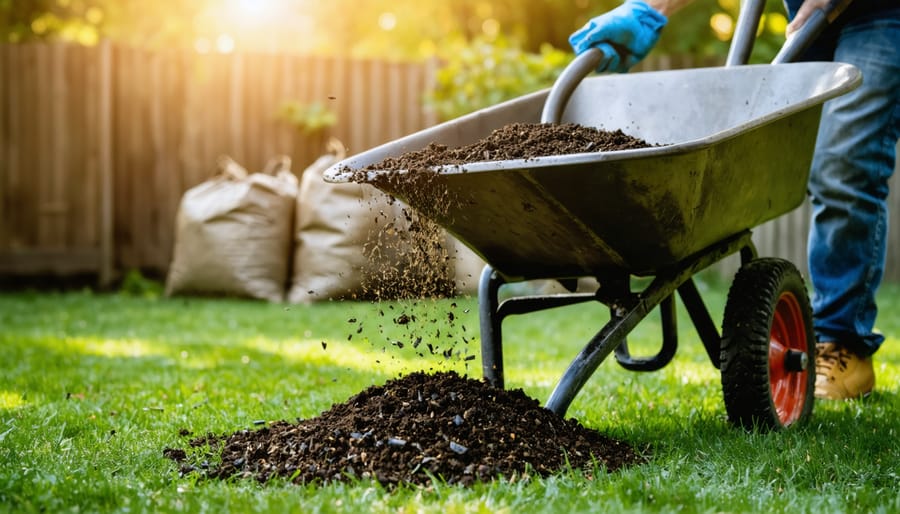Reviving a dormant lawn mower requires specific steps to avoid common starting issues and potential engine damage. Start by draining old fuel and replacing it with fresh gasoline mixed with fuel stabilizer – stale gas is the leading cause of starting failures. Clean or replace the spark plug, ensuring proper gap spacing, and check that the electrode isn’t corroded or covered in carbon deposits. Next, verify the oil level and condition, changing it if it appears dark or contaminated, as proper lubrication prevents engine seizure. Finally, clean the air filter and carburetor thoroughly, removing any debris or varnish buildup that could restrict airflow and fuel delivery. These essential maintenance steps not only get your mower running again but also protect your investment and ensure reliable performance throughout the cutting season.
Quick Safety Check Before You Start

Basic Inspection Points
Before attempting to start your lawn mower, conduct a thorough visual inspection to ensure everything’s in order. Check for any obvious damage like cracks in the housing, loose or missing bolts, and damaged cables. Pay special attention to fuel lines and electrical connections – look for signs of wear, cracks, or loose fittings. Examine the battery compartment for corrosion or any signs of battery problems that might prevent starting. Inspect the air filter housing for pest damage or debris accumulation, as rodents often nest in stored equipment. Finally, check underneath the mower for any grass buildup or rust that could affect performance. If you spot anything concerning, address these issues before attempting to start your mower to prevent potential damage or safety hazards.
Workspace Preparation
Before diving into the repair process, it’s crucial to set up a safe and organized workspace. Choose a well-ventilated area, preferably outdoors or in a garage with the door open, to avoid inhaling exhaust fumes. Place your lawn mower on a flat, stable surface – ideally a concrete pad or sturdy workbench. Ensure you have good lighting and gather all necessary tools within arm’s reach, including basic hand tools, cleaning supplies, and any replacement parts you might need.
Keep a fire extinguisher nearby as you’ll be working with fuel and potentially flammable materials. Spread out an oil-absorbent mat or cardboard beneath the mower to catch any spills and make cleanup easier. Remove any obstacles or trip hazards from your work area, and keep children and pets away while you’re working on the machine. Having everything properly arranged will make the restoration process smoother and safer.
Fuel System Revival
Old Fuel Problems
One of the most common fuel system problems occurs when gas sits in your mower for extended periods. Over time, gasoline breaks down and becomes stale, typically within 30 days of purchase. This degraded fuel can leave sticky deposits and varnish-like residues that clog your carburetor and fuel lines, making it difficult or impossible for your mower to start.
The ethanol in modern gasoline compounds this issue by attracting moisture from the air. This moisture can cause corrosion in your fuel system and lead to separation of the fuel mixture, creating a layer of water at the bottom of your tank. When this happens, your mower might sputter, run roughly, or fail to start altogether.
To prevent these issues, always use fresh fuel and consider adding a fuel stabilizer if your mower will sit unused for more than a month. For mowers that haven’t run in a while, it’s best to drain the old fuel completely and replace it with fresh gas before attempting to start the engine. This simple step often resolves many starting issues and helps protect your mower’s fuel system components.
Fuel System Cleaning
Old fuel is often the culprit when a lawn mower won’t start after sitting idle. Begin by draining the old gas from the tank – you can use a siphon or carefully tip the mower to pour it into an approved container. Next, remove and clean the fuel filter if your model has one. If it’s particularly dirty or damaged, consider replacing it.
The carburetor likely needs attention too. Start by removing the air filter and spraying carburetor cleaner into the air intake. This helps dissolve any gummy deposits that have formed. For a deeper clean, remove the carburetor bowl (usually held by a single bolt) and clean out any debris or varnish buildup using carburetor cleaner and a soft brush.
Once everything’s clean, add fresh fuel to the tank. Consider using a fuel stabilizer – it’s especially helpful if you won’t be using the mower regularly. For optimal results, use ethanol-free gas if available, as ethanol-based fuels can attract moisture and cause starting problems.
Before reassembly, check all fuel lines for cracks or brittleness. Replace any damaged lines to prevent fuel leaks. Finally, prime the engine according to your owner’s manual instructions. A clean fuel system paired with fresh gas gives your mower the best chance of starting smoothly after extended storage.
Fresh Fuel Tips
Selecting the right fuel and treating it properly is crucial for your lawn mower’s performance, especially after extended storage. Always use fresh, unleaded gasoline with an octane rating of 87 or higher. Fuel older than 30 days can cause starting problems, as gasoline begins to deteriorate and form deposits that clog the carburetor.
For best results, add a fuel stabilizer to your gas tank before storage. This helps prevent fuel degradation and protects engine components. Mix the stabilizer with fresh fuel according to the product instructions, then run the engine for a few minutes to ensure the treated fuel circulates through the system.
When refueling after storage, drain any old gas completely from the tank and fuel lines. Consider using ethanol-free gas if available in your area, as it’s less likely to attract moisture and cause starting issues. For storage periods longer than two months, either empty the fuel system entirely or keep the tank full with stabilized fuel to prevent rust and deterioration.
Remember to always store your lawn mower in a dry place and avoid using fuel containers that show signs of rust or contamination. A clean fuel system is essential for reliable starts and optimal performance.
Spark Plug Solutions
Spark Plug Check
A faulty spark plug is often the culprit behind spark plug related issues, so it’s essential to give it a thorough inspection. Start by locating the spark plug on your mower – it’s usually connected to a thick rubber wire on the engine. Carefully disconnect the wire and use a spark plug socket wrench to remove the plug. Take a close look at its condition – a healthy spark plug should have a light brown or grayish color on the electrode.
If you notice black soot, oil residue, or significant wear on the electrode, it’s time for a replacement. You can also perform a quick spark test by reconnecting the wire to the plug, holding it against the engine metal (while wearing insulated gloves), and pulling the starter cord. A strong blue spark should be visible between the electrodes.
Remember to check the spark plug gap using a gap tool – refer to your mower’s manual for the correct measurement. When reinstalling, hand-tighten the plug first to avoid cross-threading, then use the wrench to secure it properly. A new spark plug typically costs just a few dollars but can make a world of difference in starting your mower.

Cleaning or Replacement
A dirty or faulty spark plug is often the culprit when your lawn mower won’t start after sitting idle. Start by locating the spark plug on your mower’s engine – it’s usually on the side and connected to a rubber boot. Carefully disconnect the boot and use a spark plug socket wrench to remove the plug. Inspect it closely for signs of wear, damage, or carbon buildup.
If the spark plug is just dirty, you can clean it with a wire brush and gap tool. Gently brush away any deposits, paying special attention to the electrode tip. However, if you notice cracks in the porcelain insulator, excessive wear on the electrode, or heavy corrosion, it’s best to replace the spark plug entirely.
When installing a new spark plug, ensure you’re using the correct type for your mower model. Set the proper gap using a gap tool – typically between 0.020 and 0.030 inches, but check your owner’s manual for exact specifications. Thread the plug in by hand first to avoid cross-threading, then tighten it with the wrench until snug, but don’t overtighten.
Oil and Filter Care

Oil Condition Assessment
One of the first things you’ll want to check when reviving your dormant lawn mower is the oil condition. Start by locating the dipstick or oil fill port, typically found on the side or top of the engine. Remove the dipstick, wipe it clean with a lint-free cloth, and reinsert it to get an accurate reading. When you pull it out again, check both the oil level and its condition.
Fresh oil should be amber or light brown in color. If you notice the oil is black, has a gritty texture, or smells burnt, it’s time for a change. Dirty or degraded oil can’t properly lubricate your engine, potentially leading to serious damage when you start up. Also, oil that’s been sitting for months can become contaminated with condensation or fuel, making it less effective.
Before starting your mower, consider replacing the oil regardless of its appearance if it’s been sitting for more than six months. This simple step can prevent engine wear and ensure smooth operation. When adding new oil, make sure to use the grade recommended by your mower’s manufacturer, and don’t overfill – this can be just as harmful as running with low oil.
Filter Maintenance
A clogged or dirty filter system can prevent your lawn mower from starting properly after long periods of inactivity. Start by locating the air filter – it’s typically housed in a plastic or metal casing on the side of the engine. Remove the filter carefully and hold it up to the light. If you can’t see through it, it’s time for a cleaning or replacement.
For paper air filters, gently tap them against a hard surface to remove loose debris. If the filter is severely dirty or damaged, replace it with a new one. Foam filters can be cleaned with warm, soapy water, thoroughly dried, and lightly oiled before reinstallation.
Don’t forget about the oil filter if your mower has one. A dirty oil filter can restrict oil flow, potentially causing engine damage. Check your owner’s manual for the correct replacement interval, but it’s generally good practice to change it annually or every 50 hours of use, whichever comes first.
While you’re at it, inspect the filter housing for cracks or damage. Clean out any debris that may have accumulated inside, and ensure the filter fits snugly when reinstalling. A properly maintained filter system helps your mower breathe better and run more efficiently.
Starting Sequence
Now that you’ve prepared your mower, let’s walk through the starting sequence step by step. Begin by placing your mower on a level surface in a well-ventilated area. If your model has a fuel valve, turn it to the “on” position. Set the throttle control to “fast” or “rabbit” position – this ensures optimal starting conditions.
For push mowers, locate the primer bulb and press it firmly 3-4 times. Be careful not to over-prime, as this can flood the engine. If your mower has a choke, move it to the “choke” or “start” position. For riding mowers, ensure you’re seated properly with the brake pedal depressed and the cutting deck disengaged.
Position yourself behind the mower (for push models) and hold the safety bar against the handle. This is crucial as most modern mowers won’t start without this safety feature engaged. For pull-start models, grip the starter rope handle firmly and pull smoothly but forcefully. Don’t let the rope snap back – guide it slowly to prevent damage to the starting mechanism.
If the engine starts but sounds rough, gradually move the choke to “run” position. Let the engine warm up for 1-2 minutes before beginning to mow. If it doesn’t start on the first try, wait about 30 seconds before attempting again to avoid flooding the engine.
To prevent future starting issues, make regular maintenance a priority throughout the year. Before storing your mower for extended periods, drain the fuel tank or add a fuel stabilizer, change the oil, and clean or replace the air filter. Store your mower in a dry, covered area to protect it from moisture and rust. Consider running the engine every few weeks during storage periods to keep components lubricated. A little preventive care goes a long way in ensuring your mower starts reliably when you need it. Remember to keep spare parts like spark plugs and air filters on hand, and always follow your manufacturer’s maintenance schedule. By implementing these simple practices, you’ll spend less time troubleshooting and more time enjoying a well-maintained lawn.




